
Press » Interview of Judith M. Taylor, M.D.

The world is full of amazing people, each with their own story. After leaving her physician career in New York, Judith Taylor, M.D. re-invented herself! She became a well-known author in her expertise of plants.
Dr. Taylor illustrates perfectly, how just because one becomes a certain calendar age, or after they leave a fulfilling career, life continues to be grand. Do something different! Re-describe yourself.
We thank Dr. Taylor for her willingness to share her story.
Take a look below.
Dr. Taylor illustrates perfectly, how just because one becomes a certain calendar age, or after they leave a fulfilling career, life continues to be grand. Do something different! Re-describe yourself.
We thank Dr. Taylor for her willingness to share her story.
Take a look below.
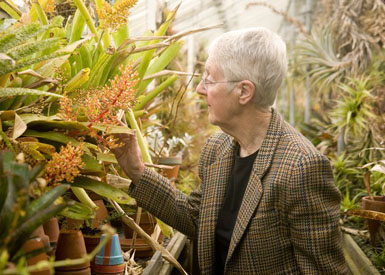
Judith in her element, with exotic orchids
Retire Early Lifestyle: Could you tell us a little about yourself?
Judith M. Taylor: I was born and educated in London and Oxford. As an only child my mother was very ambitious for me and frequently suggested I become a doctor. When I entered high school and the teacher asked me what I wanted to do, of course I replied “become a doctor”.
My mother was a “tiger mother” before that term had been invented.
When I came to the United States to do an internship, I met my husband and made my life here. We had two sons and I now have six grandchildren, a source of great joy.
REL: How have things changed for you since you left your job as a Doctor and moved to California?
JMT: After practicing neurology in Scarsdale New York for more than 30 years, I changed to administrative medicine and retired from my very challenging position as medical director of a large HMO. I was 60 then.
We moved from New York to California. What was I going to do now?
Good advice came from an odd source. The late Carolyn Heilbrun, professor of English at Columbia University (a.k.a Amanda Cross the mystery novelist), was on a lecture tour in San Francisco when I went to hear her. She said that ceasing to do anything constructive just because you had reached a particular calendar age was absurd. Rather, she said, you should find something very difficult to do and stick with it.
Interesting.
During all that period I wrote a number of brief pieces about the history of medicine. Medicine was mainly botany - until 1899 when synthetic aspirin was first sold. To me, the idea of writing a book seemed very remote.
Once we settled in our beautiful house in Tiburon CA, I had time to do many things. Since I love to cook, at first I caught up on all the recipes I had cut out of newspapers but never was able to make. Then I turned my attention to the garden. It needed a lot of work.
I knew we lived in a Mediterranean climate so I ordered two dozen olive trees. Their beauty knocked my socks off and I was hooked. Since there were no books about the trees I decided I had to write my own!
I still enjoyed cooking and playing tennis but each day now had an important purpose. In order to write a book about the history of the olive tree in California I first had to learn about the history of California itself. Then I set out to meet as many people in the olive industry as I could. There is no better way to learn about a new place than traveling its length and breadth.
Judith M. Taylor: I was born and educated in London and Oxford. As an only child my mother was very ambitious for me and frequently suggested I become a doctor. When I entered high school and the teacher asked me what I wanted to do, of course I replied “become a doctor”.
My mother was a “tiger mother” before that term had been invented.
When I came to the United States to do an internship, I met my husband and made my life here. We had two sons and I now have six grandchildren, a source of great joy.
REL: How have things changed for you since you left your job as a Doctor and moved to California?
JMT: After practicing neurology in Scarsdale New York for more than 30 years, I changed to administrative medicine and retired from my very challenging position as medical director of a large HMO. I was 60 then.
We moved from New York to California. What was I going to do now?
Good advice came from an odd source. The late Carolyn Heilbrun, professor of English at Columbia University (a.k.a Amanda Cross the mystery novelist), was on a lecture tour in San Francisco when I went to hear her. She said that ceasing to do anything constructive just because you had reached a particular calendar age was absurd. Rather, she said, you should find something very difficult to do and stick with it.
Interesting.
During all that period I wrote a number of brief pieces about the history of medicine. Medicine was mainly botany - until 1899 when synthetic aspirin was first sold. To me, the idea of writing a book seemed very remote.
Once we settled in our beautiful house in Tiburon CA, I had time to do many things. Since I love to cook, at first I caught up on all the recipes I had cut out of newspapers but never was able to make. Then I turned my attention to the garden. It needed a lot of work.
I knew we lived in a Mediterranean climate so I ordered two dozen olive trees. Their beauty knocked my socks off and I was hooked. Since there were no books about the trees I decided I had to write my own!
I still enjoyed cooking and playing tennis but each day now had an important purpose. In order to write a book about the history of the olive tree in California I first had to learn about the history of California itself. Then I set out to meet as many people in the olive industry as I could. There is no better way to learn about a new place than traveling its length and breadth.
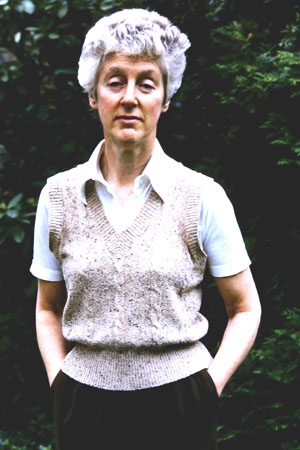
A physician in New York, Dr. Taylor age 45
REL: What has surprised you the most about your writing lifestyle after you quit your job?
JMT: The most surprising thing I found out was discovering that writing a book is addicting.
You cannot write only one book just as you cannot eat only one potato chip. Very little comes close to seeing that first book in print. It takes a long time to get it all done but along the way things pop up and tease you. I found a partially completed manuscript in the archive where I was checking for more about the olive tree. It was about the early gardens of California and it nagged at me until I decided to follow where it lead, and ended up augmenting it and publishing it as Tangible Memories (2003).
REL: How many years have you been writing and researching?
JMT: Twenty five years now.
REL: Can you tell us a bit about the life of a writer?
JMT: In writing history life gets very exciting when you find an unexpected source of information. You have to sift through a lot of dull, dry stuff but then it suddenly becomes worthwhile.
Your best friends are the librarians. I never met a librarian I did not like. To me, they are saints.
JMT: The most surprising thing I found out was discovering that writing a book is addicting.
You cannot write only one book just as you cannot eat only one potato chip. Very little comes close to seeing that first book in print. It takes a long time to get it all done but along the way things pop up and tease you. I found a partially completed manuscript in the archive where I was checking for more about the olive tree. It was about the early gardens of California and it nagged at me until I decided to follow where it lead, and ended up augmenting it and publishing it as Tangible Memories (2003).
REL: How many years have you been writing and researching?
JMT: Twenty five years now.
REL: Can you tell us a bit about the life of a writer?
JMT: In writing history life gets very exciting when you find an unexpected source of information. You have to sift through a lot of dull, dry stuff but then it suddenly becomes worthwhile.
Your best friends are the librarians. I never met a librarian I did not like. To me, they are saints.
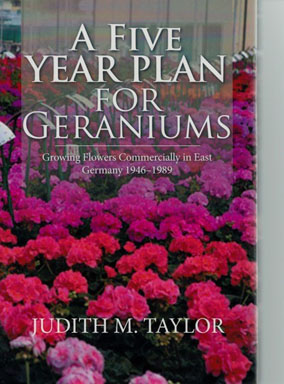
Dr. Taylor’s sixth book:
A Five Year Plan for Geraniums:
Growing Flowers Commercially
in East Germany 1946–1989
REL: How do you pick your topics?
JMT: Each topic emerged from the one which went before. Tangible Memories ends with a listing of where each of California’s exotic plants came from and when that was.
I happened to visit New Zealand to give a paper at about that time and realized that the flowers in the little front gardens in Auckland were the same as those in London or New York. It led me to examine the course of plants as they traveled round the world. The result was The Global Migrations of Ornamental Plants: how the world got into your garden. (2009)
Then I began to think about what happened to the plants after they arrived in the United States and Europe. The result was Visions of Loveliness: great flower breeders of the past (2014). No one had ever written a book about those people. As I look back it was all very logical.
REL: Do you travel for the researching of your books?
JMT: As noted above, I covered a good deal of California both for original information from people working in the field as well as to visit specialized libraries.
I went to Ithaca, New York to examine some of the holdings of the Alfred Mann Library at Cornell. I do not advise anyone to visit Ithaca in deepest February!
The other places I traveled were to the National Agricultural Library in Beltsville, Maryland, the archives of the Massachusetts Horticultural Society in Franklin, Massachusetts and the US National Archive in Washington, D C.
I am sorry that this is all rather humdrum not very exciting for the reader.
JMT: Each topic emerged from the one which went before. Tangible Memories ends with a listing of where each of California’s exotic plants came from and when that was.
I happened to visit New Zealand to give a paper at about that time and realized that the flowers in the little front gardens in Auckland were the same as those in London or New York. It led me to examine the course of plants as they traveled round the world. The result was The Global Migrations of Ornamental Plants: how the world got into your garden. (2009)
Then I began to think about what happened to the plants after they arrived in the United States and Europe. The result was Visions of Loveliness: great flower breeders of the past (2014). No one had ever written a book about those people. As I look back it was all very logical.
REL: Do you travel for the researching of your books?
JMT: As noted above, I covered a good deal of California both for original information from people working in the field as well as to visit specialized libraries.
I went to Ithaca, New York to examine some of the holdings of the Alfred Mann Library at Cornell. I do not advise anyone to visit Ithaca in deepest February!
The other places I traveled were to the National Agricultural Library in Beltsville, Maryland, the archives of the Massachusetts Horticultural Society in Franklin, Massachusetts and the US National Archive in Washington, D C.
I am sorry that this is all rather humdrum not very exciting for the reader.
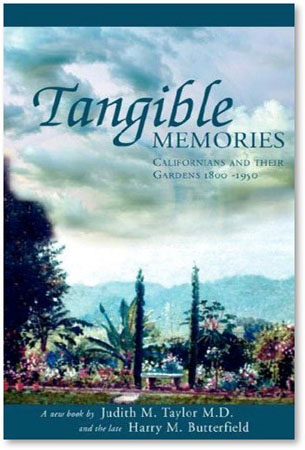
Tangible Memories: Californians and their gardens 1800 – 1950
REL: You came to learning how to use a computer later on in life. How did you teach yourself? Do you enjoy it? Do you consider your computer a friend or something you must endure in order to write your books?
JMT: I had used an office computer at my job but had never owned my own machine.
The best thing for me was to go to the local community college and take their classes. It turned out to be a very good choice. The teacher was most understanding and told us elderly ladies to work in groups. That made it easier and enhanced the lessons. The college also supplied practice labs and a most understanding graduate student to hold our collective hands.
I have no emotional response to the computer. It is now a central part of my life and as soon as I have finished breakfast I sit down at it to start my work.
REL: I understand that you pulled together the flower breeders who lived and worked behind the Iron Curtain. What was that like? Did you travel there to interview them?
JMT: Pulling the flower breeders behind the Iron Curtain together in A Five Year Plan for Geraniums: growing flowers commercially in East Germany 1946 – 1989 once again emerged from the two books which preceded it. In both Visions of Loveliness and An Abundance of Flowers which was its companion volume, there were more than a handful of amazing nurserymen who lived and worked behind the Iron Curtain.
Everyone knows what havoc Communism and socialism wrought on the lives and industries of Eastern Europe but no one had looked at it through the fragile lens of flowers.
In writing the chapter about geraniums in Vision, I was able to correspond with a woman whose grandfather ran a world famous nursery in Dresden, later becoming part of East Germany. She was the linchpin of the work, giving me names and information to get started.
Some of the leading nurserymen were exiled or even murdered in that dreadful epoch. I did have to have a couple of books translated from the German but it was very worthwhile.
JMT: I had used an office computer at my job but had never owned my own machine.
The best thing for me was to go to the local community college and take their classes. It turned out to be a very good choice. The teacher was most understanding and told us elderly ladies to work in groups. That made it easier and enhanced the lessons. The college also supplied practice labs and a most understanding graduate student to hold our collective hands.
I have no emotional response to the computer. It is now a central part of my life and as soon as I have finished breakfast I sit down at it to start my work.
REL: I understand that you pulled together the flower breeders who lived and worked behind the Iron Curtain. What was that like? Did you travel there to interview them?
JMT: Pulling the flower breeders behind the Iron Curtain together in A Five Year Plan for Geraniums: growing flowers commercially in East Germany 1946 – 1989 once again emerged from the two books which preceded it. In both Visions of Loveliness and An Abundance of Flowers which was its companion volume, there were more than a handful of amazing nurserymen who lived and worked behind the Iron Curtain.
Everyone knows what havoc Communism and socialism wrought on the lives and industries of Eastern Europe but no one had looked at it through the fragile lens of flowers.
In writing the chapter about geraniums in Vision, I was able to correspond with a woman whose grandfather ran a world famous nursery in Dresden, later becoming part of East Germany. She was the linchpin of the work, giving me names and information to get started.
Some of the leading nurserymen were exiled or even murdered in that dreadful epoch. I did have to have a couple of books translated from the German but it was very worthwhile.
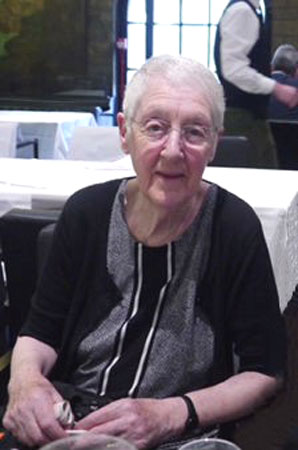
Dr. Taylor currently at home in San Francisco, California
While I was working on this last book my husband became increasingly frail and there was no way I could travel and leave him, even with good help. At that time, it was possible to do everything on line. It was a far cry from when I wrote my first book about the olive trees in California in the mid-1990s. Back then I had to ask for 8 x 10 glossy prints to illustrate my work, and wait for them to come in the mail!
REL: In your life, what is exhilarating beyond words?
JMT: Beyond the huge joys of family the most exhilarating thing for me is finding out something new which fits with whatever I am working on and can complete the puzzle.
REL: What are your greatest passions in life?
JMT: As above, beyond the great joys of family, I am devoted to fine music, reading history and cooking.
REL: Tell us about your greatest personal success, not necessarily finance related.
JMT: That scholarship to Oxford. Everything flowed from that. It lifted me from a rather modest background into a new broader world of brilliant students and quirky teachers.
REL: How do you contribute to the world?
JMT: At one time I did some volunteering but I cannot do that now. I give what I can to worthy charities.
On the other hand, a London book reviewer, Robin Lane-Fox, said he will never look at the flowers in his garden the same way again after reading Visions.
And only this morning my hairdresser told me he was planting sweet pea seeds. I told him sweet peas first reached England from Sicily in 1699 but were always the same color. Then in 1865 an English nurseryman bred them in bright scarlet, and won a gold medal for them. This set off a frenzy which lasted 40 years.
My hairdresser was shocked!
So, perhaps I have opened some perspectives about appreciating the history of flowers and plants. That makes me very happy.
REL: What is a secret fact about you?
JMT: I adore detective stories.
REL: What is your biggest splurge?
JMT: Books, books and more books!
REL: What do you do for fun or entertainment?
JMT: Go to the symphony or chamber music concerts. Do crossword puzzles. Play “Words With Friends”.
REL: What is your next project?
JMT: I am being allowed to sort through the papers of a distinguished faculty member at Stanford to see whether she left enough materials after her death to complete a book she contemplated about women and gardens.
Again, we'd like to thank Dr. Taylor for taking the time to answer our questions, and for sharing her life with us. For more information about Dr. Taylor and her six books, go to Horthistoria.
REL: In your life, what is exhilarating beyond words?
JMT: Beyond the huge joys of family the most exhilarating thing for me is finding out something new which fits with whatever I am working on and can complete the puzzle.
REL: What are your greatest passions in life?
JMT: As above, beyond the great joys of family, I am devoted to fine music, reading history and cooking.
REL: Tell us about your greatest personal success, not necessarily finance related.
JMT: That scholarship to Oxford. Everything flowed from that. It lifted me from a rather modest background into a new broader world of brilliant students and quirky teachers.
REL: How do you contribute to the world?
JMT: At one time I did some volunteering but I cannot do that now. I give what I can to worthy charities.
On the other hand, a London book reviewer, Robin Lane-Fox, said he will never look at the flowers in his garden the same way again after reading Visions.
And only this morning my hairdresser told me he was planting sweet pea seeds. I told him sweet peas first reached England from Sicily in 1699 but were always the same color. Then in 1865 an English nurseryman bred them in bright scarlet, and won a gold medal for them. This set off a frenzy which lasted 40 years.
My hairdresser was shocked!
So, perhaps I have opened some perspectives about appreciating the history of flowers and plants. That makes me very happy.
REL: What is a secret fact about you?
JMT: I adore detective stories.
REL: What is your biggest splurge?
JMT: Books, books and more books!
REL: What do you do for fun or entertainment?
JMT: Go to the symphony or chamber music concerts. Do crossword puzzles. Play “Words With Friends”.
REL: What is your next project?
JMT: I am being allowed to sort through the papers of a distinguished faculty member at Stanford to see whether she left enough materials after her death to complete a book she contemplated about women and gardens.
Again, we'd like to thank Dr. Taylor for taking the time to answer our questions, and for sharing her life with us. For more information about Dr. Taylor and her six books, go to Horthistoria.
Retire Early Lifestyle, 2019

